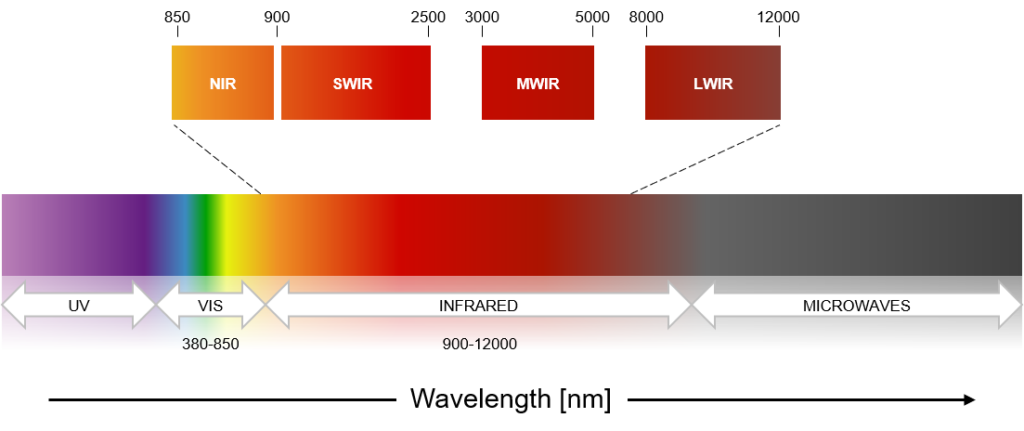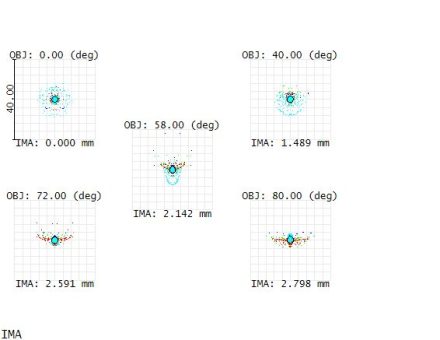Certain applications require a broad spectral operating range and customers oftentimes inquire whether a lens can perform “well” out to their wavelength of interest. These requests typically involve both visible (VIS) and near-infrared (NIR) wavelengths. For purposes of this discussion, a wavelength range roughly from 470nm (or lower) out to about 850-950nm is assumed.

Fundamentally, it is important to consider the use-case of the lens and determine how the VIS and NIR wavelengths apply in a particular system:
- whether those wavelengths will be used simultaneously,
- whether the bands will be used at distinct times (for example VIS is only used during the daytime, and at NIR is only used at night time) and there is no possibility to refocus the lens, or
- whether the bands will be used in two different instances, but there is a possibility to refocus the lens and/or adjust the image plane location
Due to the law of refraction, different wavelengths focus at different points along the optical axis (z-axis). Therefore, if a lens is not purposely optimized for NIR AND VIS wavelengths simultaneously, the ideal focus position of a lens for NIR light will occur beyond the VIS image plane.
In applications where the broadband region will be used simultaneously or in applications where the wavelength bands are used at two distinct times and there is no possibility to refocus the lens, such as examples (1) or (2) above, it is important to consider a hyperspectral lens.
A hyperspectral lens sometimes referred to as a “Day-Night” corrected lens, or also RGBIR lens refers to a lens that has been optimized to maintain performance throughout the VIS and NIR bands at a single focus position (common image plane location). The main advantage of a hyperspectral lens in terms of performance is that a single focus position will yield optimized image quality across that entire spectrum without the need to be refocused, which can be a complex process depending on the application and may negate the ability to use a fixed-focus lens.
Since it is significantly more difficult to optimize a lens over a broad wavelength range, below are some of the common challenges and trade-offs that should be considered:
- MTF Trade-off. Overall MTF across a broader wavelength region may need to be sacrificed.
- Performance at shorter wavelengths is typically sacrificed for increased performance at longer wavelengths or vice versa.
- The design typically prefers increased F/#, longer TTL, and may tend towards lower relative illumination (depending on other tradeoffs).
- Typically requires more elements to correct aberrations.
- May require aspheres to correct aberrations, especially if TTL is a constraint, which in turn can have an impact on cost.
- AR coatings on lens elements need to be optimized for broadband spectrum, so average reflectance may increase as the broadband wavelength range increases.
- With the above-mentioned complexities, typically the design becomes more sensitive to tolerances.
- MTF Trade-off. Overall MTF across a broader wavelength region may need to be sacrificed.
Please take note that the points listed above are assuming some degree of constraints within an optical system, and are meant to provide overarching ideas. In practice, each design is unique as it pertains to a particular project.

Even though there are many factors that impact MTF performance of a lens, teh above picture clearly shows the superior MTF performance across teh field for an IR-corrected (NIR) lens, compared to a lens that has been designed and optimized for the visible (VIS) spectrum only. The data show MTF vs. Field at 940nm and for different spatial frequencies.
Depending on the use-case, an alternative to hyperspectral lenses is to use a lens that has been primarily optimized for the VIS spectrum, but which can be used in the NIR range when refocused.
The benefits to choosing such a lens are that typically there are many more standard, existing options available. Designing a lens for a narrower range of wavelengths is typically a simpler process (relatively speaking), and provides for a design solution with overall higher performance. At the same time, AR coatings can achieve superior performance over a narrower wavelength range with minimal reflectance, as compared to broadband performance.
The challenges most commonly associated with such lenses occur when integrating the lens into the camera on a system level due to the need to adjust the image plane. There are two main paths of setting up the image plane to yield a functional lens in both wavebands:
- Refocus the lens; for example, the lens would be at an optimal focus position for VIS light when used during daylight when the primary source is VIS, and the image plane location would be adjusted during the night time when NIR wavelengths are more dominant, perhaps as a result of IR-LED illumination. A manual refocus is manageable in prototype scenarios, but typically is not practical for mass-produced products. Automatic focus can present more mechanical challenges, particularly in rugged environments or where weight/size is a key consideration, but otherwise will allow the lens to function optimally. Devices such as piezo modules, voice coils (VCM), and stepper motors are available with standard M12 thread.
- Choosing a singular focus position (image plane location) that is at an intermediary focus between the VIS and NIR wavelengths of interest. This will result in a decrease in MTF performance in both wavelength regions, but is often adequate for both, or can be biased toward the preferred band. The extent of the MTF drop in each wavelength region will depend on the specific lens design and other factors such as the sensor resolution.
Hyperspectral lenses should be considered in systems that require the use of both VIS and NIR light and which don’t provide the option to refocus. However, as we see, there are many trade-offs associated with designing such a lens and the customer should consider their priorities and their criteria for judging performance. On the other hand, lenses optimized for narrower wavelength ranges typically offer superior performance but may pose mechanical challenges if needing to refocus the lens to accommodate a second wavelength region.
If you are interested in lenses that perform over a broad wavelength range from Sunex, please send us an inquiry. We can help you with one of our existing hyperspectral lenses, evaluate how a standard lens will perform over your wavelengths of interest, or explore custom options.


